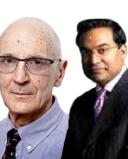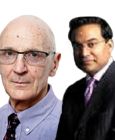Psychiatry
Inside the Mind of the Munich Mass Killer
Can Psychiatric and Psychological Research Reveal Motivations in Mass Killings?
Posted July 24, 2016
As the world tries to answer the question ‘why’ when it comes to the mass murder of innocent people in Munich, current psychiatric research uncovers patterns to apparently random and motiveless ‘mass’ killings, which might reveal clues as to their impetus.

The media are now reporting that Ali Sonboly used Facebook to lure his victims into the massacre in the shopping mall, with offers of gifts, while German Police now comment that he was suffering from clinical depression and either was receiving, or had received psychiatric treatment. It has also now emerged that he seemed to collect books about shooting rampages and various materials found suggest an "obvious link" to the 2011 Norway massacre.
Ali Sonboly had recently changed a profile picture on an online messaging service to one of Anders Breivik.
But even if Ali Sonboly turns out to have identified with Anders Breivik who killed 77 people in a double attack in Oslo and on the island of Utøya, on 22 July 2011, does this assist any deeper understanding of this kind of killer? Is the date of Munich rampage psychologically significant as an anniversary of the Norway tragedy?
Paul Mullen, Christopher Cantor and colleagues have published an analysis of possible ‘copy-cat’ mass slayings where they argue the influence of one rampage on another may have occurred across continents, and even over many years.
Their study entitled ‘Media and Mass Homicides’ published in the journal Archives of Suicide Research tracked seven mass homicide incidents occurring in Australia, New Zealand and the UK between 1987-1996. They found a complex web of multiple influences between the different incidents on the perpetrators, especially influenced by the colossal media coverage each tragedy received.
For example the perpetrator of a mass killing in Port Arthur Australia in 1996, where 35 people were slain, might have been influenced not just by the Dunblane tragedy in Scotland, where 16 children were killed just 46 days before, but also two mass killings in Melbourne, almost 10 years previously.
Mullen and colleagues point out that following research evidence that press coverage of suicides leads to ‘copy-cat’ suicides in the general population, there are now media guidelines discouraging certain kinds of reporting. Their research suggests the same guidance and restrictions should now apply to media reporting of mass killings. Of all kinds of mass murder, this type might be the most sensitive to and encouraged by media coverage.
But even if Ali Sonboly's attack was partly inspired by Anders Breivik, how much does that really help us understand the motivation behind this latest tragedy?
Controversy has continued to rage over Breivik’s sanity and mental state, and this follows very similar disagreements amongst court-appointed psychiatrists who have interviewed similar ‘lone wolf’ killers in the past, all over the world. This debate signals there is a dilemma at the heart of the profession. One core problem is how to reconcile some of the most disturbed and irrational ideas ever recorded, with such a cold, clinical execution of the final fatal acts, which themselves betray no sign of chaotic reasoning.

Posting a Facebook invitation to the deaths of his victims suggests a kind of ruthless planning within the mind of Ali Sonboly, and which Breivik’s organisation, also displayed but which doesn’t seem compatible with disordered mental states.
During his trial, Breivik’s lawyer, Geir Lippestad, told reporters his client would not only defend his actions during his 10-week trial, but added, “he will also regret that he didn’t go further.” Was this an indication of a continuing delusion - given it was hardly rational to make this statement if trying to obtain as lenient treatment as possible from a court? Does it betray the kind of failure to grasp how others view your actions, which is a cardinal sign of serious mental illness? Or is it a sign of an ultimate chilling internal consistency of ideas?
This kind of conundrum has led some psychiatrists to suggest mass or spree killers such as Breivik suffer from a rare disorder so far unclassified and unknown in the textbooks, because it’s so difficult to gather enough of a sample to study effectively. Most mass killers die as a consequence of the spree killing because of armed police intervention, or they kill themselves, leading some to speculate that this is an act of self-destruction. Embitterment and self-hatred become entwined when some recent humiliation provokes a final realisation that the central narcissistic actor is not going to ever achieve what they had their hopes pinned on all their lives. This leads them to take revenge on an unfair world which has relegated them to a bit player in history. So they decide to take the ultimate and final step to prove how wrong everyone else was to write them off.
Spree killers differ from simple homicides because the rage is directed not at an individual but at a community or the world. Also they are not at all like serial killers, who generally perpetrate killings over an extended period, not against random individuals but instead a particular type of person, such as prostitutes, for their own warped reasons.
In a paper recently published in the academic journal Psychiatric Clinics of North America, entitled ‘Mass Murder: Causes, Classification, and Prevention’, Dr James Knoll from the Division of Forensic Psychiatry, SUNY Upstate Medical University, New York, reports one of the most up to date current psychiatric understanding of mass killers.
There appear many widely held public myths around mass murder - for example, that this is a new phenomenon.
In fact Knoll cites evidence such killings have existed for decades into the past; whether mass murder as a non-terrorist psychiatric phenomenon (as the Munich tragedy so far appears to be) is increasing in frequency is still an open question. But he does wonder if the way the media reports these incidents might be shaping how they are carried out.
He cites the case of the Bath School disaster of 1927. This, and other historical cases, demonstrate psychological themes emerging from forensic analysis of modern tragedies, are indeed perennial. Andrew Kehoe’s financial problems and a gravely ill wife led to anger and despair, which he appears to have mentally ‘displaced’ on to the local Michigan community.

Eventually overwhelmed with bitter resentment, Kehoe murdered his wife, set his farm ablaze, and killed 45 others with a bomb. Kehoe committed suicide in the explosion. Like many modern-day mass murderers, he left a final communication. Inscribed on a plaque outside his property, his message read ‘criminals are made, not born’. Today he might have disseminated his note via social or news media. Dr Knoll interprets this statement as suggestive of the recurrent psychological drive underpinning many modern mass murders - ‘externalisation’ of blame combined with a long-held grievance.
Dr Knoll points to an important study by Dr Paul Mullen, a forensic psychiatrist based at Thomas Embling Hospital, Victoria, Australia, published in the academic journal Behavioural Sciences and the Law - a detailed investigation of five mass murderers. Dr Mullen’s research - entitled ‘The Autogenic (Self-Generated) Massacre’ - uncovered several common traits.
All the subjects had been bullied or isolated as children, loners who despaired over social exclusion. They were all suspicious, resentful, grudge holders, obsessional or rigid. Narcissistic and grandiose, they constantly located the source of their problems as outside of themselves. The community around them were perceived as rejecting and uncaring, not that the perpetrators were difficult or self-centred. This generated resentment and obsessive rumination on past humiliations, evolving into fantasies of vicious vengeance. They eventually came to ‘welcome death’ as bringing fame and power, the ultimate revenge and putting right of past wrongs.
Knoll contends that examples of this kind of psychopathology include Atlanta day trader Mark Barton, who shot and killed nine people and injured 13 more in 1999. Barton had become depressed and angry following financial and marital crises. He developed a resentful, hopeless attitude - his suicide note stating, “I don’t plan to live very much longer, just long enough to kill as many of the people that greedily sought my destruction”. He stormed two Atlanta day trading firms, stating, “I hope this doesn’t ruin your trading day” before initiating the shootings, then killing himself.
Murderous anger might be targeted on former employees or school mates, but if the resentment is against a community, it can be arbitrarily manifest in some public place.
Knoll cites the example of James Huberty, who killed 22 and injured 19 others at the San Diego McDonald’s shooting of 1984. Huberty explained to his wife immediately before that ‘society had their chance’ and he was ‘hunting humans’. He appeared to have chosen the McDonald’s out of familiarity and knowledge large numbers of potential victims were likely to be there.
Seung-Hui Cho, a student at Virginia Tech, in 2007 shot to death 33 students and faculty, wounding 24 more and then killed himself, and Knoll contends the pattern repeats here again. It’s expressed in the killer’s ‘manifesto’, when he rebuked other students as a result of his perception that they possessed ‘everything’ they ever wanted, such as ‘Mercedes... golden necklaces... trust funds... vodka and cognac.’ Yet, Knoll argues, the killer also reveals dark envy, stating: ‘Oh the happiness I could have had mingling among you hedonists, being counted as one of you, if only you didn’t ***** the living ***** out of me.’
Knoll’s summary is the message communicated by these mass killers is: “I carry profound hurt - I’ll go ballistic and transfer it onto you”.
Knoll wonders if the true solution to mass murder might involve a three pronged approach - better media responsibility over reporting these incidents, tighter gun regulation and improved mental health services.
He reports Seung Hui Cho, the Virginia Tech mass killer, was evaluated by a social work clinician in 2005, leading to temporary detention in a behavioural health unit. The following day, Cho was evaluated by a psychologist diagnosing him mentally ill, but not an imminent danger to self or others. Several hours later, he was released with an appointment for a counselling centre later that day.
Whether or not Cho actually kept that appointment remains unclear. There seems to have been no further mental health follow up until the shootings on April 16, 2007. Who knows how the future might have been different, if better resources meant mental health services ‘follow up’ was more meticulous?
Dr Knoll believes we cannot hold a proper debate on this issue until we grasp the killings that could have happened, but never did.
He has little doubt that over the years, unsung mental health heroes have averted many possible mass murder tragedies.
Raj Persaud and Peter Bruggen are podcast editors for the Royal College of Psychiatrists and also now have a free app on iTunes and Google Play store entitled "Raj Persaud in Conversation." See: itunes.apple and play.google. Also, Raj Persaud's new novel is 'Can't Get You Out Of My Head'.
This piece brings together material from previous articles published on this subject by Raj Persaud and Ramón Spaaij, an Associate Professor at Victoria University Melboure, which can be found here:
'Inside the Mind of a Mass Killer', http://www.huffingtonpost.co.uk/dr-raj-persaud/inside-the-mind-of-a-mas…
‘Inside the Mind of Anders Breivik - The Norwegian on Trial for Mass Murder’ http://www.huffingtonpost.co.uk/ram/anders-breivik-psychology-inside-th…
'Are Mass Killings Contagious?' http://www.huffingtonpost.co.uk/dr-raj-persaud/batman-shooting-mass-kil…




